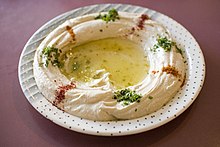| Revision as of 22:53, 9 March 2008 view sourceViridae (talk | contribs)13,898 edits rv that - i disagree with the validity of the source← Previous edit | Revision as of 22:54, 9 March 2008 view source Viridae (talk | contribs)13,898 edits →Israel: rem part of sentanceNext edit → | ||
| Line 32: | Line 32: | ||
| ===Israel=== | ===Israel=== | ||
| Hummus is a common part of everyday meals in Israel |
Hummus is a common part of everyday meals in Israel.<ref>Even mentioned by the ''] Cookbook'', see ''Houston Chronicle'' "".</ref> Many restaurants in ] are dedicated to hummus and its variations. Hummus is typically garnished with warm, cooked chickpeas, olive oil, ] and parsley. Toppings include minced meat, pine nuts, ], or a warm ] stew.<ref> | ||
| {{cite web | {{cite web | ||
| |url= http://www.ynet.co.il/english/articles/0,7340,L-3401347,00.html | |url= http://www.ynet.co.il/english/articles/0,7340,L-3401347,00.html | ||
Revision as of 22:54, 9 March 2008
- For the biological matter in soil, see Humus; for the band, see Humus (band).

Hummus (also variously spelled hamos, houmous, hommos, hommus, hummos, hummous or humus) is a dip or spread which in modern recipes is made from blended chickpeas, sesame tahini, lemon juice and garlic. Hummus has been a dietary staple in various local forms throughout the Middle Eastern world for thousands of years.
The name comes from the Arabic word for chickpeas حُمُّص (pronounced hummus). The full name in Arabic is حُمُّص بالطحينة (hummus bi tahina) which means chickpeas with tahini.
History
The origins of hummus are unknown. It is one of the oldest known prepared foods and has been used in Middle Eastern and Mediterranean cuisine for thousands of years. Plato and Socrates both noted the nourishing benefits of hummus (hommos in Greek), which has been a part of Greek culture at least since classical times. An ancient Egyptian recipe calls for wine vinegar instead of lemon juice, which did not arrive in the Middle East until about the 8th century CE. Hummus' main ingredient, the chickpea, was one of the earliest crops cultivated in Mesopotamia. Researchers say its nutritional benefits may have led to the early rise of civilization there.
Serving methods
| This section needs additional citations for verification. Please help improve this article by adding citations to reliable sources in this section. Unsourced material may be challenged and removed. (March 2008) (Learn how and when to remove this message) |

As an appetizer and dip hummus is scooped with flatbread (such as pita). Among school children, it is often used as a filling in sandwiches served for lunch or as snacks. Hummus is also used as part of a meze, as a dressing for dishes such as falafel, grilled chicken, fish or eggplant. It may be garnished with chopped or thinly-sliced tomato, cucumber, cilantro, sautéed mushrooms, whole chickpeas, olive oil and hard-boiled egg. Outside the Middle East it may be eaten with tortilla chips and crackers of various kinds.
Hummus Ful (pronounced /fuːl/) is topped with a paste made from fava beans boiled until soft and then crushed into a mush. Hummus Masubha/Mashawsha is a mixture of hummus paste, warm chickpeas and tahini.
Lebanon
In Lebanon hummus may be garnished with colorful vegetables along with parsley and sumac. Pickled turnips along with pickled cucumbers and hot green peppers may be served on the side with a traditional garnish of sour pomegranate seeds.
Hummus Awarma is topped with minced meat, onions and pine nuts.
Palestine

In Palestine hummus has been a staple food, where chickpeas are often enjoyed fresh off the vine. Hummus has always been present in at least one meal and is garnished with olive oil and mint leaves, paprika, parsley, or cumin.
Egypt
Hummus is traditionally garnished with cumin in Egypt.
Jordan
In Jordan Hummus mahluta (also known as Kudshiya) is covered with a combination of ful paste and warm chick peas.
Israel
Hummus is a common part of everyday meals in Israel. Many restaurants in Israel are dedicated to hummus and its variations. Hummus is typically garnished with warm, cooked chickpeas, olive oil, paprika and parsley. Toppings include minced meat, pine nuts, hard-boiled eggs, or a warm mushroom stew.
Nutritional information
Hummus is high in iron and vitamin C. The chickpeas make it a good source of protein and dietary fiber. Depending on the recipe hummus carries varying amounts of monounsaturated fat. Hummus is useful in vegetarian and vegan diets and like other combinations of grains and pulses, when eaten with bread it provides most of the essential amino acids for humans.
References
- ^ eddybles.com, Feta Artichoke Hummus, retrieved 28 February 2008
- ^ mideastfood.about.com, Hummus 101, retrieved 28 February 2008
- ancientnile.co.uk, Ancient Niles Ancient Egyptian Recipes, retrieved 28 February 2008
- http://www.newscientist.com/article/mg19325854.300-brainy-chickpeas-conquered-the-world.html
- chron.com, NO McDONALDS / What's for lunch for kids overseas?
- Ibrahim, Lailie, Institute for Middle East Understanding, Hummus, a Palestinian staple, 31 March 2006, retrieved 9 March 2008
- Even mentioned by the Israel Defense Force Cookbook, see Houston Chronicle "Diversity in the dining room helps ring in Israel's new year".
- "Land of hummus and pita (a hummus glossary)". Ynetnews. Retrieved 2008-03-07.
- Hummus NutritionData.com